Discover
The cairn of Gavrinis is mainly discovered from the port of Larmor-Baden and, after a short and pleasant crossing, you will stop, in the heart of the Gulf of Morbihan, on the island of Gavrinis to visit one of the most exceptional prehistoric sites in France: a monumental funerary architecture of dry stone, housing a dolmen.
We invite you to consult our "individual visits" section to discover all our visits, as well as the different ports of departure.
Erected more than 6000 years ago, the cairn of Gavrinis is now recognized throughout the world for the profusion of its engraved ornamentations.
To discover Gavrinis is to enjoy a breathtaking panorama of the Gulf of Morbihan, between Berder, Er Lannic, the island of the Mare, the peninsula of Rhuys and further on the horizon, the mouth of the Gulf and the ocean.
To discover Gavrinis is to go back in time. Built nearly 6,000 years ago, in the Neolithic, long before Stonehenge, the famous pyramids of Egypt and the Moai of Easter Island, the cairn of Gavrinis is a funerary architecture of dry stone, housing a burial of our distant ancestors.
To discover Gavrinis is to admire a jewel of prehistory. The cairn of Gavrinis is remarkable for its dimensions: more than 50 m in diameter, 6 m high, and for its ornamentations. It offers a profusion of engravings of rare finesse, which are not found anywhere in the world. Axes, bows, spirals… are represented, but what do they symbolize? Why did Neolithic men erect such a monument? Who were they? How did they live?
« … There are, in Gavrinis, in Morbihan, on other menhirs, arabesques stirring like wrinkles on the surface of low water, undulations, tremors of algae, which must be signs of conjuration or magic. (
Élie Faure, Histoire de l'art. Ancient Art G. Crès, 1926)
The cairn of Gavrinis is recommended by the Michelin, the Routard and the Petit Fûté.
"We visited in a privileged setting. I kept my distance from the group to try to feel the sensations of my contemporaries of yesteryear, and to immerse myself in all these energies present in the ground, probably intact, which make it possible to abolish the ages and to feel immediacy. Not just as a contemplative, but as an asset, as if it were possible to be a man of an infinitely remote age and I got there. If we disregard the boats, we are in a kind of fraternity with these disappeared societies, very evolved in terms of existential questioning. When you enter this underground and see these engravings, you realize that there is a meaning, but you do not know which one. It is important that the mysteries of man are not solved. Even if these mysteries remain mysterious, we can clearly see that we are in the presence of a message probably addressed to the gods, to the deities, to the invisible. It's upsetting, these men had exchanges about their origin, about their future after death. They inscribed their haunting in these stones that they reserved for the stay of the disappeared, exactly like the Egyptians but in older times. What I also liked was the site of the Gulf of Morbihan, which lends itself to burial. There is something extremely protected, which escapes the notion of timing. Oneself escapes the notion of time. One has the impression that there is a kind of funerary vocation, tomb of the place, not in the gloomy, melancholic sense, but a tranquility deserved by the living at the end of their painful earthly journey. These stone manuscripts are our own hieroglyphics. We are free to dream about their meaning and we have the impression of being in the pages of a stone book whose meaning we do not understand, but the meaning is there anyway, in a sibylline way. I love the presence around these tombs, the matrix presence of water, as if there was any hope of resurrection. »
Yann Queffelec
Remarkable for its dimensions, the cairn of Gavrinis measures more than 50 meters in diameter and 6 meters high, for a total volume of 6600 m3.
Built in the Neolithic, between 4250 and 4000 BC, the cairn of Gavrinis is a dry stone construction, a vestige of a funerary site. The cairn of Gavrinis covers a dolmen with corridor 14 m long, at the end of which is the only burial chamber, almost square, of 2.50 m side. Built, the cairn of Gavrinis is indeed for funerary purposes. Selected members of the society were certainly buried there accompanied by prestigious objects (axes, jewelry, ceramics …).
It now dominates the Gulf of Morbihan, but 6000 years ago, it overlooked the deep channel of the Vannes River. By being part of the landscape in this way, it fulfills a symbolic function and attests to the will of Neolithic men to organize and mark their territory.
Through the guided tour, you will discover the history of the monument and the period that saw it erected. Commonly known as "the Sistine of the Neolithic", the cairn of Gavrinis is a real architectural and ornamental treasure, whose scientists are constantly trying to understand the meaning of this rich engraved decoration because the 29 slabs that make up the interior of the monument are almost all entirely engraved…
"Almost all the stones composing its walls are carved and covered with bizarre designs. They are curves, straight lines, broken, drawn and combined in a hundred different ways (…) There are still chevrons, zigzags and many other features impossible to describe" (Prosper Mérimée, Notes de voyages dans l'Ouest de la France, 1836)
A fascinating discovery!
Visiting the cairn of Gavrinis, you will be surprised by the technical prowess of the men and women of the Neolithic in the erection of such a monument, by the exuberance of the engravings, but also by the very origin of the slabs. Some come from far away. One of them, of more than 23 tons, was for example, moved over 4 km, at a time when the Gulf of Morbihan was not yet the "little sea" that we know today… The visit of the cairn of Gavrinis reveals a large number of mysteries…
Did you know that stones speak?
To prepare your family visit, listen to the podcasts of "Petite pierre et grande pierre" before coming…

Episode 1
Episode 2
Episode 3
Episode 4
Episode 5

Podcast series made with Bayam, edutainment application of the Bayard group and Milan Jeunesse.

"It is a unique place extremely strong, strong by its history, its aesthetics its unique character, its inscription in the landscape, in one of the most beautiful bays in the world A place of peace. If I think I am rather rational, this site refers us to what is deepest and most constant in humanity. A place built against death, in what is most beautiful and permanent in Brittany: stone. This site awakens in us the desire to live and be happy. There is hope, this is probably what we call energy. A place that speaks to our collective unconscious, without our knowledge. We are resourcing ourselves in the country, in that it is more essential. And when we see that it dates from 7000 years ago, it is nothing at all, a second on the scale of humanity. We are there, in the human, dna s what is most constant and most violently filled with hope. These men lived in a complicated world, able to fetch jadeite in the Alps. It would be for us to go to the planet Mars! And these people (who look like us) believed in symbols, in the power of symbols that make sense, in poetry at every moment of our lives. And if we, if we forget that, we are dead."
"I was already touched even before I came back to Gavrinis, after 25 years. I have been fascinated by these famous engravings since childhood because I am fascinated by the artistic universe of all eras, especially the oldest. There we are in an art that announces Celtic art. I don't see a break. There is a continuity of these curves, these spirals… which touched me emotionally even before looking for concrete representations. We return to the vibrations of the universe. I feel that way and I don't see why people at the time shouldn't feel that way too. We are in the birth of life, of the universe. We are in the vibration. The primordial vibration, but also the musical vibration which is something very present in my life, and the aquatic aspect of course. These curves and spirals represent a world in perpetual motion, in continuity, in dynamics. A world that refuses stability, that is always in creation, in a vital momentum. The elements are not separated, have no borders."
"To the extent that I am a reader of myself, I have the feeling when I come back here, in Morbihan, especially here, that I am trying to find myself as I could be during my childhood on vacation. And things didn't move, to my delight. There is a kind of community between the present and this childhood that is nevertheless distant. Because I hadn't come in 30 years. This parcel of land and sea has remained the same. This is very troubling to me. It is a re-immersion in another time. It's something very intimate in the end. »
"When you visit a place like the cairn, you arrive on a tumulus, a megalithic site, alignments, menhirs… We are already immersed in a universe of questions. This is fantastic, because man only advances and progresses if he asks questions and is in the questioning. So when you are lucky, in addition, to have like here, a guided tour with an intimate knowledge of things, it makes you want to go even further. […] We are indeed in a pre-Celtic universe. Many people confuse elsewhere, believing that menhirs and dolmens were born with bards and druids. It has nothing to do with it. But all of this complements the questions people are asking. So, we are in a kind of chain of questions and when we arrive at a site like this with explanations, we necessarily want first to go further, secondly to work to make known this precursor world and thirdly to do everything to safeguard it, beautify it, make it known, go further, hence the campaign currently undertaken to obtain a classification of megalithic sites at Unesco. This should have been done a long time ago. It is vital in history and in the memory of humanity. We are here in a slice of memory, that's what is fantastic. In addition, the site on the Gulf of Morbihan is undoubtedly one of the most beautiful in the world. No writer here can come out of there insensitive, it's impossible. There are vibrations that are a source of inspiration."



